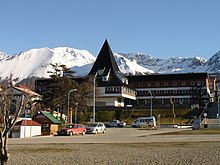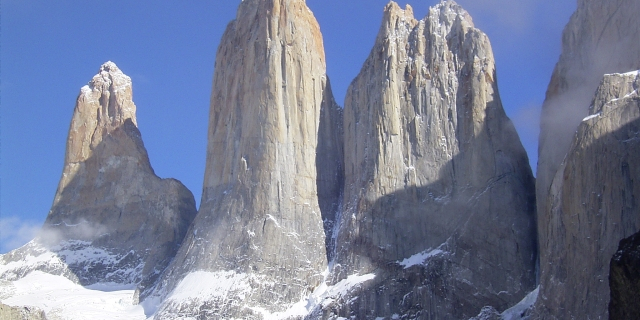Ushuaia ( oo-SWY-ə, Spanish: [uˈswaja]) is the capital of Tierra del Fuego, Antártida e Islas del Atlántico Sur Province, Argentina. With a population of 82,615 and a location below the 54th parallel south latitude, Ushuaia claims the title of world's southernmost city.
Ushuaia is located in a wide bay on the southern coast of Isla Grande de Tierra del Fuego, bounded on the north by the Martial mountain range and on the south by the Beagle Channel. It is the only municipality in the Department of Ushuaia, which has an area of 9,390 km2 (3,625 sq mi). It was founded on 12 October 1884, by Augusto Lasserre and is located on the shores of the Beagle Channel surrounded by the mountain range of the Martial Glacier, in the Bay of Ushuaia. Besides being an administrative center, it is a light industrial port and tou...Read more
Ushuaia ( oo-SWY-ə, Spanish: [uˈswaja]) is the capital of Tierra del Fuego, Antártida e Islas del Atlántico Sur Province, Argentina. With a population of 82,615 and a location below the 54th parallel south latitude, Ushuaia claims the title of world's southernmost city.
Ushuaia is located in a wide bay on the southern coast of Isla Grande de Tierra del Fuego, bounded on the north by the Martial mountain range and on the south by the Beagle Channel. It is the only municipality in the Department of Ushuaia, which has an area of 9,390 km2 (3,625 sq mi). It was founded on 12 October 1884, by Augusto Lasserre and is located on the shores of the Beagle Channel surrounded by the mountain range of the Martial Glacier, in the Bay of Ushuaia. Besides being an administrative center, it is a light industrial port and tourist hub. Ushuaia is located roughly 1,100 kilometres (680 mi) from the Antarctic Peninsula and is one of five internationally recognized Antarctic gateway cities.
The Selk'nam people, also called the Ona, first arrived in Tierra del Fuego about 10,000 years ago. The southern group of people indigenous to the area, the Yaghan (also known as Yámana), who occupied what is now Ushuaia, lived in continual conflict with the northern inhabitants of the island.[1]
For much of the latter half of the 19th century, the eastern portion of Tierra del Fuego was populated by a substantial majority of nationals who were not Argentine citizens,[clarification needed] including a number of British subjects. Ushuaia was founded informally by British missionaries, following previous British surveys, long before Argentine nationals or government representatives arrived there on a permanent basis. The British ship HMS Beagle, under the command of Captain Robert FitzRoy, first reached the channel on January 29, 1833, during its maiden voyage surveying Tierra del Fuego.[2] The city was originally named by early British missionaries[3] using the native Yámana name for the area. Much of the early history of the city and its hinterland is described in Lucas Bridges’s book Uttermost Part of the Earth (1948). The name Ushuaia first appears in letters and reports of the South American Mission Society[3] in England.[clarification needed] The British missionary Waite Hockin Stirling[4] became the first European to live in Ushuaia when he stayed with the Yámana people between 18 January and mid-September 1869. In 1870 more British missionaries arrived to establish a small settlement. The following year the first marriage was performed. During 1872, 36 baptisms and seven marriages and the first European birth (Thomas Despard Bridges) in Tierra del Fuego were registered.[5] The first house constructed in Ushuaia was a pre-assembled three room home prepared in the Falkland Islands in 1870 for Reverend Thomas Bridges. One room was for the Bridges family, a second was for a Yámana married couple, while the third served as the chapel.[6]
 Building of the government of the province in the city of Ushuaia, with typical local architecture.
Building of the government of the province in the city of Ushuaia, with typical local architecture.Thomas Bridges learned the Yaghan language and was a fluent speaker. To a lesser extent he was able to communicate in the Ona (forest dwellers) language. His missionary work was mainly directed at the Yaghans. The word Yamana simply means "people" in the Yaghan language. He wrote a dictionary of the Yaghan language, the original manuscript of which is in the British Museum. As the Yaghans had no ability nor means to write, Thomas Bridges had to construct an alphabet which was suited to the phonetics of the language. The original manuscript was lost three times but recovered and almost published under an incorrect name. More than one alphabet has been used over the years in the rendering of this dictionary. The odyssey of the manuscript covered nearly half a century before it was finally published. Natalie Goodall was instrumental in reprinting the dictionary in 1987 and providing valuable insights into the history of Thomas Bridges' work. Copies of the dictionary provide material on the letters and pronunciations used which in many respects differ from the alphabet used in the English language. (Ref: A de la Rue).
 Southern Fuegian Railway
Southern Fuegian RailwayDuring 1873, Juan and Clara Lawrence, the first Argentine citizens to visit Ushuaia, arrived to teach school. That same year Julio Argentino Roca, who later served as Argentine President twice, promoted the establishment of a penal colony for re-offenders, modeled after one in Tasmania, Australia, in an effort to secure permanent residents from Argentina and to help establish Argentine sovereignty over all of Tierra del Fuego.[7][8] But only after the Boundary treaty of 1881 between Chile and Argentina did formal efforts get under way to establish the township and its prison.
During the 1880s, many gold prospectors came to Ushuaia following rumors of large gold fields, which proved to be false.[9][10] On 12 October 1884, as part of the South Atlantic Expedition, Commodore Augusto Lasserre established the sub-division of Ushuaia,[11] with the missionaries and naval officers signing the Act of Ceremony. Don Feliz M Paz was named Governor of Tierra del Fuego and in 1885 named Ushuaia as its capital. In 1885 the territory police was organized under Antonio A. Romero with headquarters also in Ushuaia. But it was not until 1904 that the Federal Government of Argentina recognized Ushuaia as the capital of Tierra del Fuego.[5] The prison was formally announced in an executive order by the then-Acting President Roca in 1896.[5][clarification needed]
Ushuaia suffered several epidemics, including typhus, pertussis, and measles, that much reduced the native population. But because the Yámana were not included in census data, the exact death toll is not known. The first census was held in 1893, which recorded 113 men and 36 women living in Ushuaia.[5] By 1911 the Yámana had all practically disappeared, so the mission was closed.[12] The population grew to 1,558 by the 1914 census.[clarification needed]
In 1896 the prison received its first inmates, mainly re-offenders and dangerous prisoners transferred from Buenos Aires, but also some political prisoners. A separate military prison opened in 1903 at the nearby Puerto Golondrina. The two prisons merged in 1910, and that combined complex still stands today.[4][13] Thus, during the first half of the 20th century, the city centered around the prison built by the Argentine government to increase the Argentine population and to ensure Argentine sovereignty over Tierra del Fuego.[7][8] The prison was intended for repeat offenders and serious criminals, following the example of the British in Tasmania and the French in Devil's Island.[8] Escape from Tierra del Fuego was similarly difficult, although two prisoners managed to escape into the surrounding area for a few weeks.[7] The prison population thus became forced colonists and spent much of their time building the town with timber from the forest around the prison. They also built a railway to the settlement,[14] now a tourist attraction known as the End of the World Train (Tren del Fin del Mundo), the southernmost railway in the world.
 Argentine Navy seaplane, one of the first to arrive to Ushuaia in the 1930s
Argentine Navy seaplane, one of the first to arrive to Ushuaia in the 1930sThe prison operated until 1947, when President Juan Domingo Perón closed it by executive order in response to the many reports of abuse and unsafe practices.[4][13] Most of the guards stayed in Ushuaia, while the prisoners were relocated to other jails farther north. After the prison closed, it became a part of the Base Naval Ushuaia (in Spanish), functioning as a storage and office facility until the early 1990s.[15] Later it was converted into the current Museo Maritimo de Ushuaia.[16]
The naval base at Ushuaia was active during the Falklands War of 1982. The Argentine cruiser ARA General Belgrano, subsequently sunk by the British Fleet, sailed from the Port of Ushuaia, where a memorial was erected in February 1996.
 Argentine Navy Ships In Ushuaia
Argentine Navy Ships In Ushuaia


































Add new comment